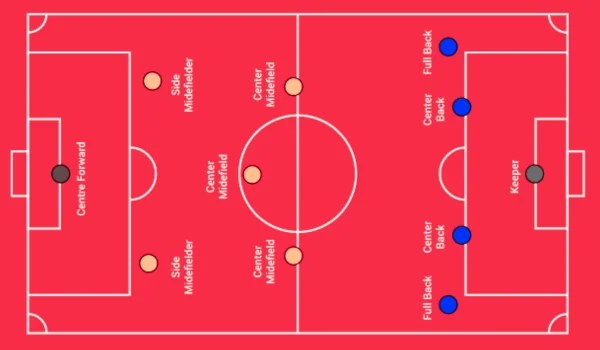Football, known as soccer in some parts of the world, is the most popular sport globally. One of the reasons for its universal appeal is the simplicity of its rules, especially regarding the number of players involved. A common question among new fans and aspiring players is: how many players are there in football? Understanding the total number of players, both on the field and in a team, is essential for grasping how the game works. This article will break down everything you need to know about the number of players in football, including different formats, substitutions, and roles.
How Many Players Are There in a Football Team?

In a standard football match, each team starts with 11 players on the field, making a total of 22 players during gameplay. The 11 players consist of:
- Goalkeeper (1 player) – The only player allowed to use their hands within the penalty area.
- Defenders (usually 4 players) – Positioned near their goal to stop the opposition from scoring.
- Midfielders (usually 3-5 players) – The engine of the team, linking defense and attack.
- Forwards (usually 1-3 players) – Primarily responsible for scoring goals.
This setup represents the total players in football on the pitch during a standard 11-a-side game. However, this number can change depending on the formation and tactics employed by the team manager.
No of Players in Football: Official Regulations
According to the Laws of the Game set by the International Football Association Board (IFAB) and governed by FIFA:
- The minimum number of players a team can continue with during a match is 7.
- If a team has fewer than 7 players due to injuries, red cards, or other reasons, the match is abandoned.
- The maximum number of players on the field per team is 11, including the goalkeeper.
Thus, the no of players in football during regular play is 22 (11 per team).
Substitutions and Squad Size: Total Players in Football
While only 11 players from each team are on the pitch, the total players in a football team during a competition is larger because of substitutes. Here’s how it works:
Substitutions in Professional Football
- Teams are typically allowed 5 substitutions during regular time in professional leagues (a rule introduced after the COVID-19 pandemic).
- In extra time (knockout matches), an additional substitution may be permitted.
- Previously, teams were limited to 3 substitutions per game.
Squad Size
- In major tournaments like the FIFA World Cup, teams can register up to 26 players.
- For domestic leagues, such as the English Premier League, the squad size can be up to 25 players, excluding players under 21 years old.
- In club football, squads may vary in size, but only a certain number of players can be selected for a particular matchday lineup.
Therefore, when considering substitutes, the total players in football per team on a matchday can be as high as 18 players (11 starters + 7 substitutes).
Different Formats: How Many Players Are There in Football?
Although the standard form of football involves 11 players per team, various other formats exist, especially at the amateur level or in different competitions. Let’s explore:
1. 5-a-Side Football
- No of players in football: 5 players per team (including the goalkeeper).
- Played on smaller pitches, often indoors.
- Substitutions are unlimited.
2. 7-a-Side Football
- No of players in football: 7 players per team.
- Played on slightly larger pitches than 5-a-side.
- Popular for youth leagues and recreational matches.
3. 9-a-Side Football
- No of players in football: 9 players per team.
- Often used as a developmental stage for youth players transitioning to 11-a-side matches.
4. Futsal
- No of players in football (futsal): 5 players per team.
- Played indoors on hard surfaces with a smaller, heavier ball.
5. Beach Soccer
- No of players in football (beach soccer): 5 players per team.
- Played on sand, with matches divided into three 12-minute periods.
Each format adjusts the total players in football according to the playing surface, purpose, and age group involved.
Roles of Players in Football Teams
Understanding how many players are there in a football team also involves knowing their roles. The 11 players in a traditional football lineup are strategically positioned to balance attack and defense:
- Goalkeeper (1): Last line of defense, preventing the opposition from scoring.
- Defenders (2-5): Center-backs, full-backs, and wing-backs responsible for stopping attacks.
- Midfielders (3-5): Central midfielders, defensive midfielders, and attacking midfielders who control play.
- Forwards (1-3): Strikers and wingers focused on creating and converting scoring opportunities.
The flexibility in formations, such as 4-4-2, 4-3-3, or 3-5-2, shows how managers can deploy their total players in football to suit different tactics.
Impact of Player Numbers on Strategy
The no of players in football influences how teams approach games. For example:
- Reduced-player matches like 5-a-side are fast-paced, requiring quick reflexes and constant movement.
- 11-a-side football involves complex tactics, where each player’s position and role significantly impact team performance.
Furthermore, red cards (resulting in player ejection) can force teams to play with fewer players, drastically changing strategies and dynamics.
Conclusion: How Many Players Are There in Football?
To sum up:
-
How many players are there in football?
➔ 11 players per team in standard football matches, totaling 22 on the pitch. -
How many players are there in a football team (including substitutes)?
➔ Up to 18 players on matchday squads and 26 players in major tournament squads. -
No of players in football varies in alternative formats like 5-a-side (5 players per team), 7-a-side (7 players), and futsal (5 players).
-
Total players in football worldwide account for millions, from professional leagues to grassroots levels, reflecting the sport’s global appeal.
Understanding these player dynamics enhances appreciation for football’s strategic complexity and universal charm. Whether it’s a professional 11-a-side match or a casual 5-a-side game, the beauty of football lies in how players, regardless of the number, work together to achieve victory.






